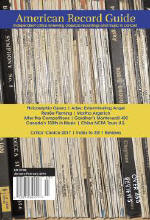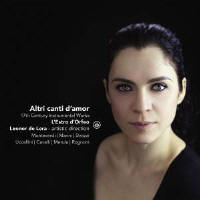Texte paru dans: / Appeared in: |
|
|
Outil de traduction ~ (Très approximatif) |
|
|
Reviewer: Catherine
Moore
Yes, we do know this title
from Monteverdi’s Book 8 madrigal of the same name. In the 17th Century,
instruments—most notably the cornetto and the newly-invented violin—sought
to emulate the human voice, and composers often made instrumental versions
of vocal pieces. Furthermore, performers added ornaments to the already
elaborate instrumental diminutions. On top of this, we have the frequent
(almost constant) poetic theme of love and the sought-after skill of
“sprezzatura” by which artists (and courtiers) strove to make the execution
of extremely difficult tasks appear easy. Such elegant nonchalance was the
ideal. All these captivating attributes of 17thCentury music-making align
precisely with the genesis and purpose of the L’Estro D’Orfeo ensemble,
whose six players combine to play baroque violins, cornetto, viola da gamba,
theorbo, baroque guitar, and harpsichord. They play as one, with deft tempo
fluctuations, stylish energy, and vivid color. Each instrument takes a turn
in the spotlight, from the soaring cornetto in Merula’s ‘Chiacona A 3 Col
Basso’ to virtuosic violin in Marini’s ‘Sonata Prima Sopra Fuggi Dolente
Core’ and a lead role for viola da gamba in Rognoni’s ‘Ancor Che Col Partire’.
Founder and director Leonor De Lera includes her own diminutions on an aria
from Cavalli’s Gli Amori D’Apollo E Di Dafne, beginning with the bass line
plus theorbo, then effectively building up and releasing tension through the
ground bass cycles, introspective and flamboyant by turns. Regarding the
ensemble’s choice of pitch, A=466 (common in Northern Italy at the time and
a semitone higher than 440), it’s clearly a deliberate aesthetic choice. The
added tension leads to “higher precision response from the [gut] strings and
the appearance of certain natural harmonics, as well as giving greater
clarity and brilliance to the sound”. Notes and bios. This is the ensemble’s
debut recording. More, please! | |
|
Support us financially by purchasing this disc from eiher one of these
suppliers. Un achat via l'un ou l'autre des fournisseurs proposés contribue à défrayer les coûts d'exploitation |
|
|
|
|
|
Cliquez l'un ou l'autre
bouton pour découvrir bien d'autres critiques de CD |
|




